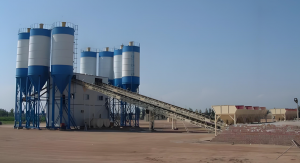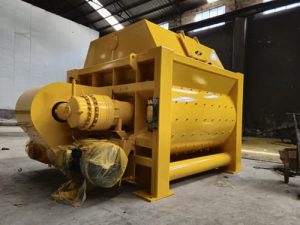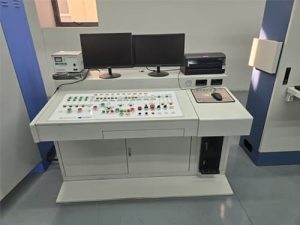Relative News
Products
Equipment introduction
Minrui JS1000 concrete mixer is a commonly used construction engineering equipment, with beautiful appearance, good internal layout, compact structure, easy operation, uniform mixing, high degree of automation, widely used in various concrete construction projects, construction projects and medium and small prefabricated component factories, can meet the needs of different projects for concrete mixing.

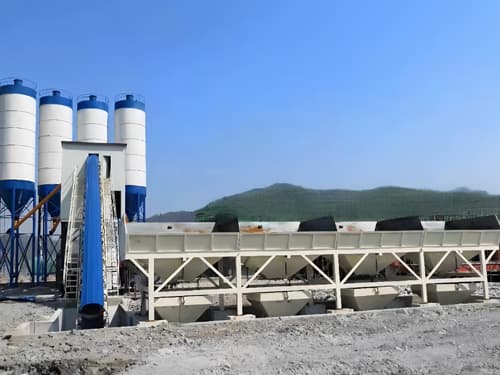
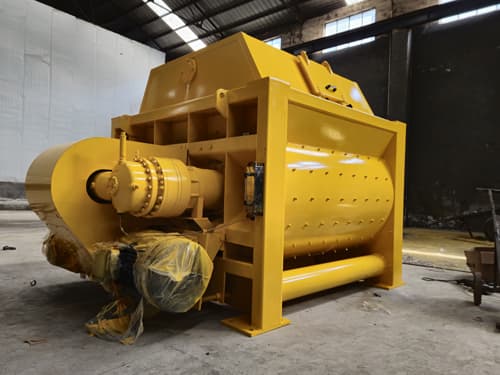
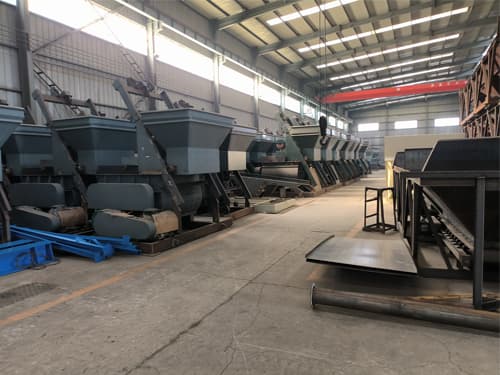
Key technical parameters
- Production capacity:
Generally speaking, the production capacity of this 1m3 concrete mixer can reach about 50-60 cubic meters per hour, but the specific value will be affected by many factors such as the nature of raw materials, mixing time and operation mode. The theoretical productivity of Minrui JS1000 mixer equipment can reach 60m³/h per hour, some other factories equipment productivity ≥50m³/h, and some equipment theoretical productivity ≤50m³/h.
- Mixer drum speed:
The mixer drum speed is usually controlled within a certain range, generally between 20 and 30 revolutions per minute, and can be adjusted according to actual needs to ensure that the concrete can be fully mixed and evenly mixed. For example, the mixing blade speed of Minrui 1000L JS1000 concrete mixer is 25.5r/min.
- Feed capacity and discharge capacity:
The feed capacity of Minrui 1m3 concrete mixer is about 1600-2000 liters and the discharge capacity is 1000-1250L, ensuring that the corresponding production needs can be met during one mixing process. Of course, the specific feed capacity needs to be reasonably adjusted according to the actual project situation and mixing requirements.
Basic parameters
- Motor power:
The motor power required to drive the mixing drum to rotate is 2x22kw. Some equipment also uses dual 2×18.5kw motors, which are sufficient to cope with various conventional mixing tasks. In actual operation, the appropriate motor power should be selected according to the equipment load and power supply conditions to ensure the stable operation of the equipment and energy saving and environmental protection.
- Dimensions:
The dimensions include length, width and height. Generally speaking, the length of the equipment is about 4 to 4.5 meters, the width is about 2.2 meters, and the height depends on the specific situation. For example, the dimensions of a certain equipment in transport and working states are 4100x2200x2250mm and 4500x3280x5350mm respectively.
Equipment performance
- Mixing effect:
Some equipment adopts double-horizontal shaft forced mixing method, which can ensure uniform mixing of concrete and improve concrete quality. The gap between the mixing blade and the arc lining is controlled within 5mm, which further ensures the mixing effect. There are also equipment with multiple mixing blade angles to meet the various needs of users, with good mixing quality. The slump of concrete inside the mixer can be monitored and changed, which can produce high-quality concrete finished materials for users.
- Transmission stability:
The reducers of Minrui JS1000 mixer equipment are independently designed and developed, with strong overload resistance and stable transmission, which can reduce the equipment failure rate.
- Safety:
It has functions such as short-circuit protection, overload protection, and phase failure protection to ensure that the equipment operates in a safe state.
Equipment advantages
- Wide range of applications:
JS1000 concrete mixer can mix dry concrete, plastic concrete, fluid concrete, lightweight aggregate concrete and various mortars, etc..
- Easy to operate:
The 1m3 concrete mixer is designed to be user-friendly and easy to operate, which reduces the difficulty of operation and labor intensity.
- Easy maintenance:
Minrui concrete mixer equipment is easy to maintain in terms of structural design.
Our advantages
The electric lubricating oil pump makes the shaft end seal better and more fuel-efficient; the design is more reasonable, the friction and impact of the material are less, the flow is smoother, the mixing time can be reduced, and the efficiency is higher; there is a protective hoop on the mixing shaft, the concrete is not easy to agglomerate, and it also protects the mixing shaft, making it less prone to wear, etc..
- User evaluation:
Minrui JS1000 concrete mixer equipment has excellent performance in terms of price, performance, quality, and after-sales service. Users believe that the equipment has strong mixing power, wear resistance, high efficiency, and thoughtful after-sales service.
JS1000 1m3 Concrete Mixer Operation Process
Preparation before starting:
Site and equipment installation: The concrete mixer should be set in a flat position, and the front and rear axles should be padded with square wood to raise the tires to prevent them from moving when starting. At the same time, secondary leakage protection should be implemented.
- Power supply inspection:
After the power is turned on before work, it must be carefully checked and can only be used after the empty vehicle test is qualified. Check whether the electrical control power supply is a 380V three-phase four-wire power supply, and whether the voltage allowable error is within ±10%. If the user provides his own power supply, the capacity should be ≧100KVa.
Also check whether the electrical components in the distribution box are normal, and whether the air switch, fuse, thermal relay, etc. can normally play the short-circuit protection and overload protection functions.
- Test run inspection:
Check whether the mixing drum speed is appropriate. Under normal circumstances, the empty vehicle speed is slightly faster than the heavy vehicle (after loading) by 2-3 revolutions.
If the difference is large, the ratio of the driving wheel to the transmission wheel should be adjusted.
The rotation direction of the mixing drum should be consistent with the direction indicated by the arrow. If not, the motor wiring should be corrected.
Check whether the transmission clutch and brake are flexible and reliable, whether the wire rope is damaged, whether the track pulley is in good condition, whether there are obstacles around, and the lubrication of various parts, etc.
Parameter setting:
Adjust the time relay timing according to the mixing time, and pay attention to adjust it when the power is off .
- Start-up operation:
Empty vehicle test run: Before mixing, an empty vehicle test run should be carried out to make the engine run for several minutes under no-load conditions, and observe whether the instrument display is normal. After confirming that there is no abnormality in the operation of each component, press the start button to run the machine.
- Wet mixing drum:
Wet the mixing drum, blades and site with water.
Feeding and mixing:
The brake motor of the feeding system drives the drum to rotate through the reducer, and the wire rope passes through the pulley to pull the hopper up along the feed rack track.
When it climbs to the specified height, a pair of rollers on the hopper door at the bottom of the hopper enter the feed rack water track, and the hopper door automatically opens, and the material is put into the mixing drum through the feed nozzle.
The size of the braking torque is adjusted by the large nut at the rear seat of the motor.
Put the concrete raw materials into the hopper, open the hopper, pour the raw materials into the mixer, start the mixer, and mix according to the set mixing time and speed.
Precautions during operation:
- Fault handling:
If an electrical or mechanical failure occurs during the process, part of the mixed material should be unloaded to reduce the load, and the machine should be started after the fault is eliminated.
- Safety inspection:
During operation, regular inspections should be carried out to prevent safety accidents such as electric shock and mechanical injuries. At the same time, after starting the machine, you should always pay attention to whether the operation of each component of the concrete mixer is normal.
Unloading:
- Normal unloading:
The unloading system consists of a unloading door, an air pump, a reversing valve, an air distributor, a cylinder, an electrical and other mechanisms. The unloading door is installed at the bottom of the mixer, and pneumatic unloading is achieved through a cylinder. The opening and closing position of the unloading door can be sealed by adjusting the position of the sealing strip. After the mixing is completed, the unloading door is controlled to open and the concrete is poured out.
- Emergency unloading:
The manual unloading lever is used for emergency unloading during temporary power outages and unloading when the cylinder fails. It should be removed at ordinary times to avoid injury.
Shutdown cleaning:
- Residual material handling:
When the concrete mixing is completed or it is expected to stop for more than 1 hour, in addition to clearing out the residual material, stones and clean water should be poured into the shaking barrel, the machine should be turned on, and the mortar stuck on the barrel should be rinsed and unloaded. There should be no water accumulation in the barrel to prevent the barrel and blades from rusting.
- Power off:
After the test, turn off the power, clean the mixing barrel and the site, and clean up. After get off work and when the machine is not in use, the power should be turned off and the switch box should be locked to ensure safety.
